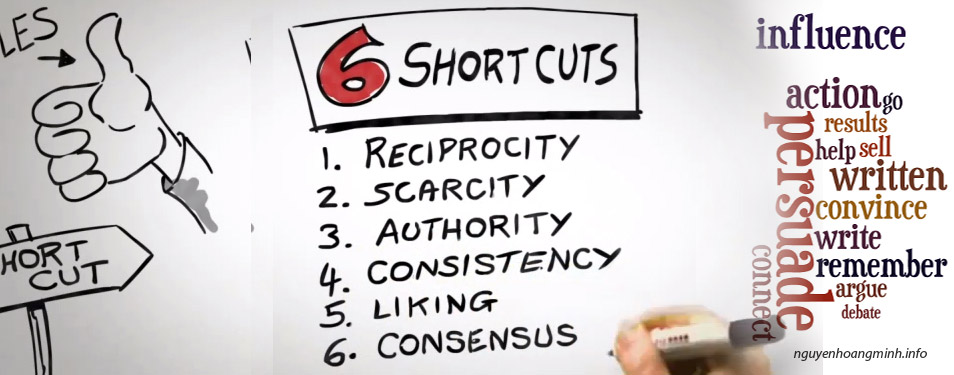The lesson for executives from these two experiments is that persuasion can be extremely effective when it comes from peers. The science supports what most sales professionals already know: Testimonials from satisfied customers work best when the satisfied customer and the prospective customer share similar circumstances. That lesson can help a manager faced with the task of selling a new corporate initiative. Imagine that you’re trying to streamline your department’s work processes. A group of veteran employees is resisting. Rather than try to convince the employees of the move’s merits yourself, ask an old-timer who supports the initiative to speak up for it at a team meeting. The compatriot’s testimony stands a much better chance of convincing the group than yet another speech from the boss. Stated simply, influence is often best exerted horizontally rather than vertically.
The Principle of Consistency:
People align with their clear commitments.
The Application:
Make their commitments active, public, and voluntary.
Liking is a powerful force, but the work of persuasion involves more than simply making people feel warmly toward you, your idea, or your product. People need not only to like you but to feel committed to what you want them to do. Good turns are one reliable way to make people feel obligated to you. Another is to win a public commitment from them.
My own research has demonstrated that most people, once they take a stand or go on record in favor of a position, prefer to stick to it. Other studies reinforce that finding and go on to show how even a small, seemingly trivial commitment can have a powerful effect on future actions. Israeli researchers writing in 1983 in the Personality and Social Psychology Bulletin recounted how they asked half the residents of a large apartment complex to sign a petition favoring the establishment of a recreation center for the handicapped. The cause was good and the request was small, so almost everyone who was asked agreed to sign. Two weeks later, on National Collection Day for the Handicapped, all residents of the complex were approached at home and asked to give to the cause. A little more than half of those who were not asked to sign the petition made a contribution. But an astounding 92% of those who did sign donated money. The residents of the apartment complex felt obligated to live up to their commitments because those commitments were active, public, and voluntary. These three features are worth considering separately.
There’s strong empirical evidence to show that a choice made actively—one that’s spoken out loud or written down or otherwise made explicit—is considerably more likely to direct someone’s future conduct than the same choice left unspoken. Writing in 1996 in the Personality and Social Psychology Bulletin, Delia Cioffi and Randy Garner described an experiment in which college students in one group were asked to fill out a printed form saying they wished to volunteer for an AIDS education project in the public schools. Students in another group volunteered for the same project by leaving blank a form stating that they didn’t want to participate. A few days later, when the volunteers reported for duty, 74% of those who showed up were students from the group that signaled their commitment by filling out the form.
The implications are clear for a manager who wants to persuade a subordinate to follow some particular course of action: Get it in writing. Let’s suppose you want your employee to submit reports in a more timely fashion. Once you believe you’ve won agreement, ask him to summarize the decision in a memo and send it to you. By doing so, you’ll have greatly increased the odds that he’ll fulfill the commitment because, as a rule, people live up to what they have written down.
Research into the social dimensions of commitment suggests that written statements become even more powerful when they’re made public. In a classic experiment, described in 1955 in the Journal of Abnormal and Social Psychology, college students were asked to estimate the length of lines projected on a screen. Some students were asked to write down their choices on a piece of paper, sign it, and hand the paper to the experimenter. Others wrote their choices on an erasable slate, then erased the slate immediately. Still others were instructed to keep their decisions to themselves.
The experimenters then presented all three groups with evidence that their initial choices may have been wrong. Those who had merely kept their decisions in their heads were the most likely to reconsider their original estimates. More loyal to their first guesses were the students in the group that had written them down and immediately erased them. But by a wide margin, the ones most reluctant to shift from their original choices were those who had signed and handed them to the researcher.
This experiment highlights how much most people wish to appear consistent to others. Consider again the matter of the employee who has been submitting late reports. Recognizing the power of this desire, you should, once you’ve successfully convinced him of the need to be more timely, reinforce the commitment by making sure it gets a public airing. One way to do that would be to send the employee an e-mail that reads, “I think your plan is just what we need. I showed it to Diane in manufacturing and Phil in shipping, and they thought it was right on target, too.” Whatever way such commitments are formalized, they should never be like the New Year’s resolutions people privately make and then abandon with no one the wiser. They should be publicly made and visibly posted.
